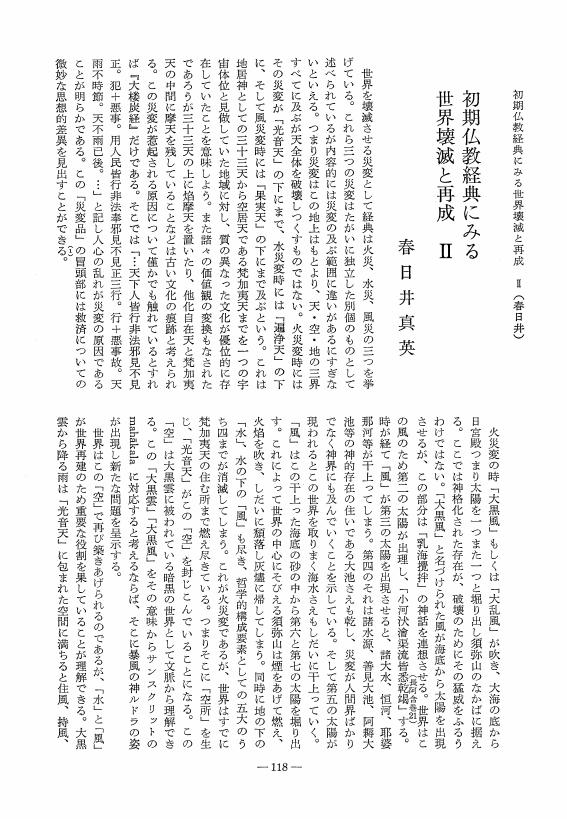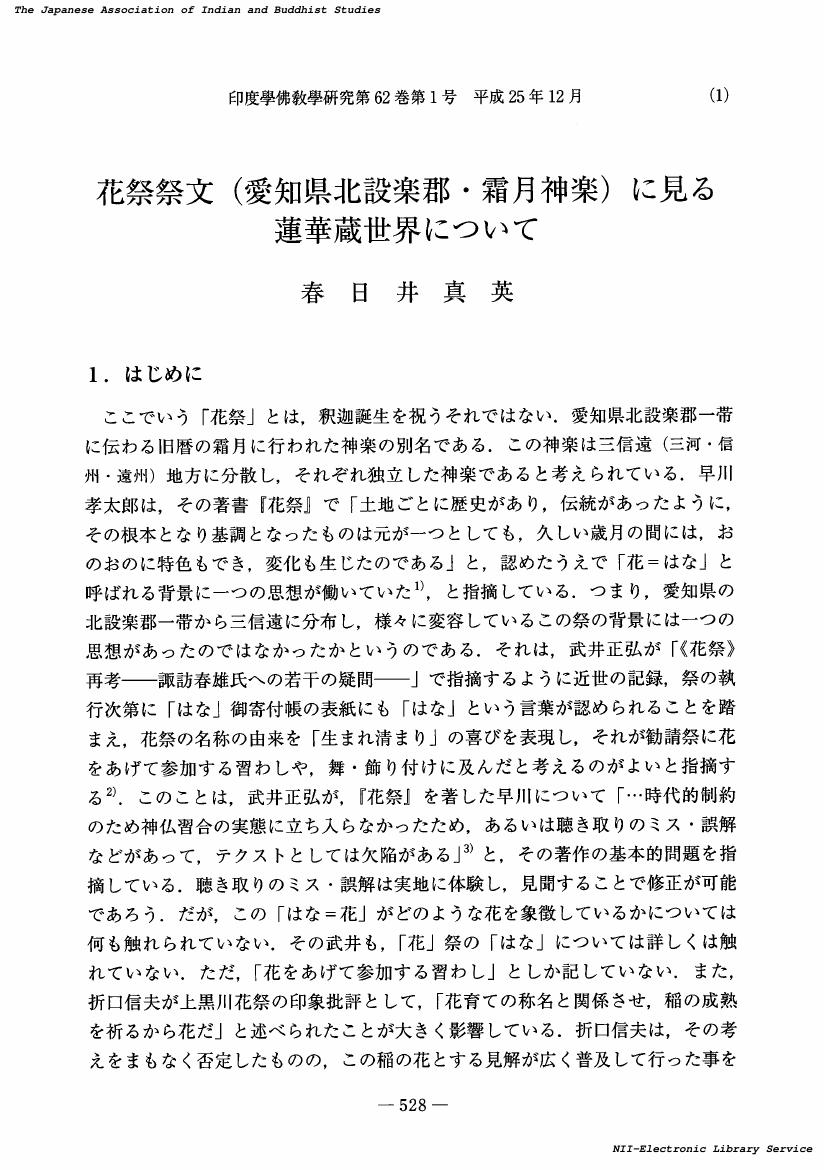5 0 0 0 OA 飾り瓦考 : 屋根の上に広がる世界
- 著者
- 春日井 真英
- 出版者
- 東海学園大学
- 雑誌
- 東海学園大学研究紀要. 人文学・健康科学研究編 (ISSN:1349161X)
- 巻号頁・発行日
- vol.10, pp.1-18, 2005-03-31
屋根の上にある鬼面の瓦、鬼瓦は日本人にはかなり馴染みがある。しかし、この鬼面の瓦は一般には寺院などでしか見ることができない。民家の飾り瓦には他の図案のものが存在するのである。また、屋根の装飾は瓦の図案だけではなく瓦の上に置かれた「留め蓋」、「置き蓋」によってもなされる。だがこれも民家では一般的なモノではない。しかし寺、神社という宗教的施設では獅子や牡丹の花などの置き蓋の飾りを見ることができる。だが、調べるうちに一般的な民家でもこの飾りが置かれていることが判る。それらは、獅子や牡丹の花といったものではなく、宝船、七福神、それに波頭といったものによってなされている。七福神や宝船などの屋根飾りの象徴性を分析することから、家という空間を日本人がどのように意識していたかを考察することができる。著者は屋根の飾りの意匠を通して、そこには富の招致もしくは富を護る呪術が隠されていると考えたい。
4 0 0 0 OA 水のコスモロジー : 異界との接点としての水辺<1> : 天竜水系の伝承を中心として
- 著者
- 春日井 真英
- 出版者
- 東海学園大学
- 雑誌
- 紀要 (ISSN:02858428)
- 巻号頁・発行日
- vol.25, pp.165-178, 1990-07-20
2 0 0 0 豊川水系に見る十一面観音と津島神社の分布と文化的背景の考察。
四年にわたる調査研究を通じて至った結果は、十一面観音、牛頭天王(津島信仰)を個々に考えてはならないと言うことであった。これまでは、個々の問題を検討していたが地域を通じて考えてみると、この二柱に加えて地蔵も重要な機能を有していることが伺われるのである。そこには、神仏習合思想に基づく思想を見て取ることができ、この事を解明する手段として「牛頭天王島渡り」の祭文の研究が急務と言うことになる。この祭文に寄れば、津島神は牛頭天王であり、その本地は薬師如来となりそこには行疫神であると同時に施薬を行うという相反する機能を有しているのである。東三河各地を検討してみると素蓋鳴神社(進雄社)が多々存在し、その名を有する神社での祭礼に鬼が顕れるのだが、その鬼達の姿は喜々としている様に見受けられる。また、豊橋市の安久美神戸神明社の鬼祭と地域の宗教施設などを検討してみると、地域全体(ここでは豊橋市)が牛頭天王と十一面観音によって護られているかの様な構造を有していることが判る。この事は、名古屋市も同じであり、名古屋城を中心として各恵方に観音を配置するという構造とも重なるのかも知れない。とくに、尾張部では鬼こそ出ないものの山車によって天王(津島あるいは牛頭天王)が祀られている事を考えれば、東三河地区での様に鬼の顕れる祭祀が、山車という象徴的な祭祀に変化してきていることが伺われる。
1 0 0 0 OA 初期仏教経典にみる世界壊滅と再成 II
- 著者
- 春日井 真英
- 出版者
- Japanese Association of Indian and Buddhist Studies
- 雑誌
- 印度學佛教學研究 (ISSN:00194344)
- 巻号頁・発行日
- vol.31, no.1, pp.118-119, 1982-12-25 (Released:2010-03-09)
1 0 0 0 OA 花祭祭文(愛知県北設楽郡・霜月神楽)に見る蓮華蔵世界について
- 著者
- 春日井 真英
- 出版者
- 日本印度学仏教学会
- 雑誌
- 印度學佛教學研究 (ISSN:00194344)
- 巻号頁・発行日
- vol.62, no.1, pp.528-521, 2013-12-20 (Released:2017-09-01)
1 0 0 0 OA 仏教経典にみる洪水の問題について
- 著者
- 春日井 真英
- 出版者
- JAPANESE ASSOCIATION OF INDIAN AND BUDDHIST STUDIES
- 雑誌
- 印度學佛教學研究 (ISSN:00194344)
- 巻号頁・発行日
- vol.32, no.1, pp.172-173, 1983-12-25 (Released:2010-03-09)
1 0 0 0 OA 右に廻るもの : 神話的視野から見える女性
- 著者
- 春日井 真英
- 出版者
- 東海学園大学
- 雑誌
- 研究紀要 (ISSN:13421514)
- 巻号頁・発行日
- vol.4, pp.151-170, 1999-03-31
It is said that there was a woman, who was named Lilith, before Eve appears in the Old Testament. This first woman was built from dust by the God at the same time as Adam was built. The woman was supposed to be Adam's nice partner, but Lilith ignored the order of the God, and she left the place, where the God prepared for them to stay. So the God had to make Adam's new partner Eve, this time from Adam's rib. One of the characteristics of Lilith was her fertility, it is said that she had many children (demons), but by refusing the order of the God to return and stay with Adam, she had to lost a hundred children in each day by the punishment of the God. And she vowed to inflict harm on infants of men. We can say that Lilith's fertility is one of the charateristics of the Great-mother, or Terra-mater, at the same time she is known as a child slayer and destroyer, on the other hand she is a catering mother to children. It is easy to illustrate her characters, but an important point is that her activities were all based on her free wish, independent to the God, also independent to man. Lilith was independent, fertile and at the same time she was a terrible mother. But this fearful character was not only Lilith's. We find the same natures in the story of Harity ([鬼子母神]Woman, who appears in the Buddhist legends) and Japanese Goddess lzanami [イザナミ]. I believe that Lilith's behavioral patterns are very important factors to think about contempolary women in this age of feminism. From this perspective, I try to extract and describe the woman figures of these days, using the poems, mainly of Miyuki Nakajima [中島みゆき]. And from her poems I come to conclude that the natures of women are not changed since Lilith or other goddesses were described. Not only contempolar women possess the same characters but these are, may be I can say, unaltered and would be reserved by the women from long long ago. If they lost or changed this Lilithness, then women would be not women at that time.
- 著者
- 春日井 真英
- 出版者
- 東海学園大学
- 雑誌
- 紀要 (ISSN:02858428)
- 巻号頁・発行日
- vol.28, pp.163-176, 1993-09-01






